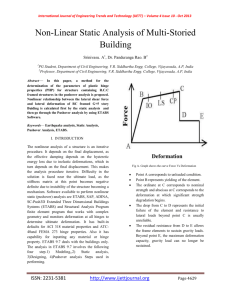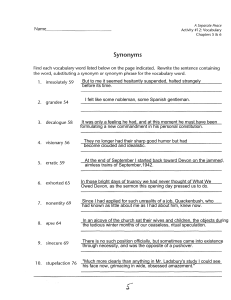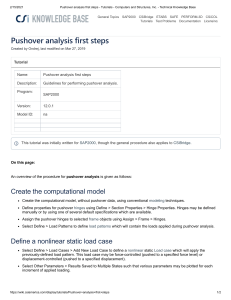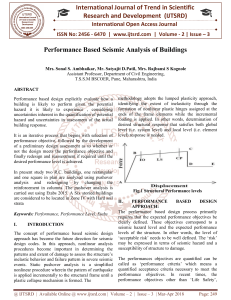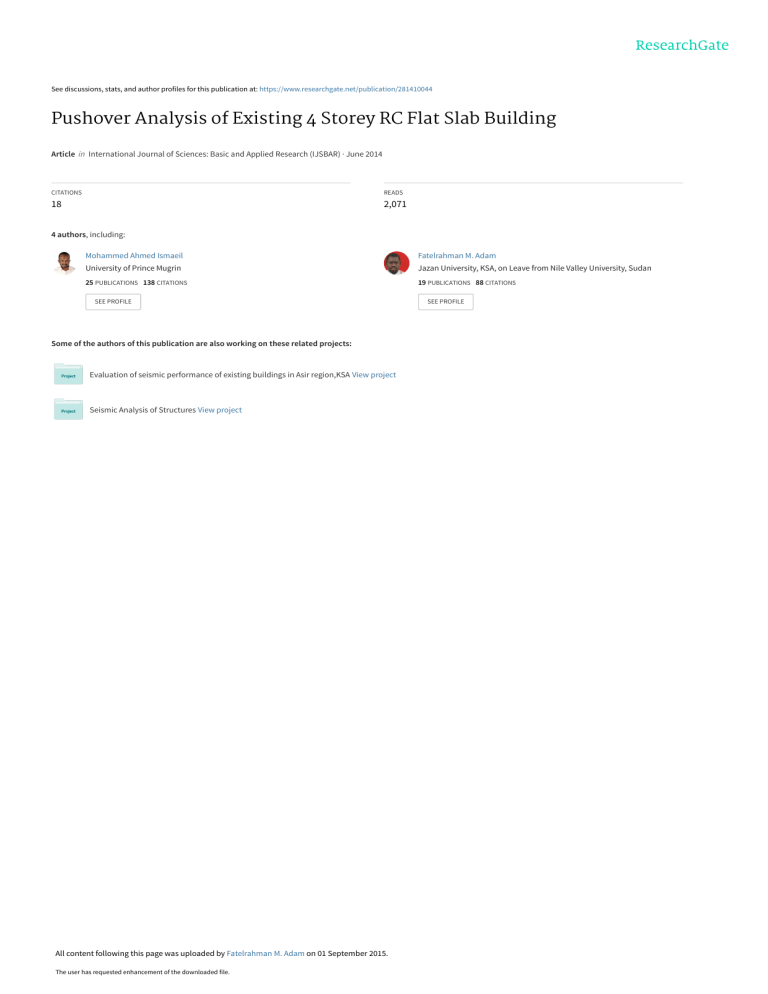
See discussions, stats, and author profiles for this publication at: https://www.researchgate.net/publication/281410044 Pushover Analysis of Existing 4 Storey RC Flat Slab Building Article in International Journal of Sciences: Basic and Applied Research (IJSBAR) · June 2014 CITATIONS READS 18 2,071 4 authors, including: Mohammed Ahmed Ismaeil Fatelrahman M. Adam University of Prince Mugrin Jazan University, KSA, on Leave from Nile Valley University, Sudan 25 PUBLICATIONS 138 CITATIONS 19 PUBLICATIONS 88 CITATIONS SEE PROFILE Some of the authors of this publication are also working on these related projects: Evaluation of seismic performance of existing buildings in Asir region,KSA View project Seismic Analysis of Structures View project All content following this page was uploaded by Fatelrahman M. Adam on 01 September 2015. The user has requested enhancement of the downloaded file. SEE PROFILE International Journal of Sciences: Basic and Applied Research (IJSBAR) ISSN 2307-4531 (Print & Online) http://gssrr.org/index.php?journal=JournalOfBasicAndApplied --------------------------------------------------------------------------------------------------------------------------- Pushover Analysis of Existing 4 Storey RC Flat Slab Building A. E. Hassaballa a*, M. A. Ismaeil b, A. N. Alzeadc, Fathelrahman M. Adamd a b Department of Civil Engineering, Jazan University, Jazan, KSA Department of Civil Engineering, King Khalid University, Abha, KSA c d Department of Civil Engineering, TaifUniversity, Taif, KSA Department of Civil Engineering, Jazan University, Jazan, KSA a b Email: tomali99@yahoo.com Email: abunama79@hotmail.com c Email: dralzaed@gmail.com d Email: fat470@yahoo.com Abstract A four-story residential existing reinforced concrete building in the city of Khartoum-Sudan, subjected to seismic hazard ,was analyzed. Plastic hinge is used to represent the failure mode in the beams and columns when the member yields. The pushover analysis was performed on the building using SAP2000 software (Ver.14) and equivalent static method according to UBC 97. The principles of Performance Based Seismic Engineering are used to govern the analysis, where inelastic structural analysis is combined with the seismic hazard to calculate expected seismic performance of a structure. Base shear versus tip displacement curve of the structure, called pushover curve, is an essential outcomes of pushover analysis. The pushover analysis is carried out in both positive and negative x and y directions. Default hinge properties, available in some programs based on the FEMA -356 and Applied Technology Council (ATC-40) guidelines are used for each member. One case study has been chosen for this purpose. The evaluation has proved that the four-story residential building is not seismically safe. Keywords: Pushover analysis; Reinforced concrete; Seismic performance; ATC-40; FEMA -356. -----------------------------------------------------------------------* Corresponding author. E-mail address: tomali99@yahoo.com . 242 International Journal of Sciences: Basic and Applied Research (IJSBAR)(2014) Volume 16, No 2, pp 242-257 1. Introduction The purpose of pushover analysis is to evaluate the expected performance of structural systems by estimating its strength and deformation demands in design earthquakes by means of static inelastic analysis, and comparing these demands to available capacities at the performance levels of interest. The equivalent static lateral loads approximately represent earthquake induced forces. A plot of the total base shear versus top displacement in a structure is obtained by this analysis that would indicate any premature failure or weakness. Many researchers have conducted studies in this area such as [1] which presented a research paper on "Pushover Analysis of Unsymmetrical Framed Structures on Sloping Ground". The paper deals with non-linear analysis of various symmetric and asymmetric structures constructed on plain as well as sloping grounds (30° slope) subjected to various kinds of loads. The analysis has been carried out using SAP2000 and ETABS software. The paper concluded that the structure with vertical irregularity is more critical than a structure with plan irregularity. For the increase of seismic zoning factor over many parts of Indian continent and based on FEMA-356 and ATC-40 guidelines. The authors in [2] carried out "a Pushover Analysis of a 4 Storey's Reinforced Concrete Building" aiming to evaluate the zone-IV selected reinforced concrete building to conduct non-linear static analysis (pushover analysis) using SAP 2000.The study showed that hinges have developed in the beams and columns showing the three stages immediate occupancy, life safety and collapse prevention. The authors in [3] performed a pushover analysis on a 19 story, slender concrete tower building located in San Francisco with a gross area of 430000 square feet. The lateral system of this building consists of concrete shear walls and it was designed conforming to 1997 Uniform Building Code (UBC), and pushover analysis was performed to verify code's underlying intent of Life Safety performance under design earthquake. Utilizing the results from the analysis, some modifications were made to the original code-based design so that the design objective of Life Safety performance is expected to be achieved under design earthquake.In 2013 M. A. Ismaeil and his colleagues (the Authors of this paper) presented a series of earthquake researches on "Assessment of Seismic Performance and Strengthening of RC Existing Residential Buildings in the Sudan" [4], "Seismic Retrofitting of a RC Building by Adding Steel Plate Shear Walls" [5], and "Effects of Earthquake loads on Existing School Buildings in Sudan" [6]. These studies were conducted to investigate the performance of samples of existing RC buildings in the city of Khartoum – Sudan. 2. Description of Study Case The case performed in this study is a typical four-story model for residential building. The building is constructed from a reinforced concrete structural frame. The structure members are made of in-situ reinforced concrete. The overall plan dimension is 20 m x 17.5 m. Height of the building is 12 m. The floor is a flat slab system with 200 mm thickness and cross-sections of columns and beams are 40 cm *25 cm for columns and 50 cm *25 cm for beams. Figures 1 to 3 show detailed information of the structural and architectural layout. 2.1. Numerical model Numerical models for the case have been prepared using SAP2000 version 14 (Computers and Structures) [7]. Beams and columns are modelled as frame elements and slabs are modelled as shell elements. In this paper the 243 International Journal of Sciences: Basic and Applied Research (IJSBAR)(2014) Volume 16, No 2, pp 242-257 seismic performance of the considered residential building was evaluated using the nonlinear static analysis procedure (Pushover Analysis). 2.2. Load cases For the pushover analysis, three load cases were considered: 1. PUSHGRAVITY (Applying the gravity loads). 2. PUSH+X and PUSH-X (Appling lateral loads in the X-X direction). 3. PUSH+Y and PUSH-Y (Appling lateral loads in the Y-Y direction). Fig.1.Plan of residual buildings considered Fig. 2.Southelevation 244 International Journal of Sciences: Basic and Applied Research (IJSBAR)(2014) Volume 16, No 2, pp 242-257 Fig. 3.Section x-x Fig. 4. Model of the 4-story residual building 3. Seismic Loads on the Building 3.1. Base shear force The Uniform Building Code (UBC1997) [8] requires that the “design base shear”, V, is to be evaluated from the following formula: V= Cv I W RT (1) The total design base shear does notneed to exceed the following: V= 2.5 Ca I W R (2) 245 International Journal of Sciences: Basic and Applied Research (IJSBAR)(2014) Volume 16, No 2, pp 242-257 The total design base shear shall not be less than the following: V = 0.11C a IW (3) V = total design lateral force or shear at the base. W = total seismic dead load 3.2. Equivalent lateral static loads The base shear force is distributed as a lateral force, which affects the joint, at each level of the building. For our case study, the distribution of the lateral seismic loads is shown in Table 1. for both directions. Table 1. Lateral loads distribution with heights by using UBC 97 Story level Wi Hi Wihi KN M 4 7734.5 12 92814 3 7734.5 9 2 7734.5 1 7734.5 SUM 30938 Wihi/sum Wihi V Lateral Force KN X Y 0.4 2660.7 1064.28 1064.28 69610.5 0.3 2660.7 798.21 798.21 6 46407 0.2 2660.7 532.14 532.14 3 23203.5 0.1 2660.7 266.07 266.07 2660.7 2660.7 232035 4. Pushover Analysis The pushover analysis is a static non-linear analysis under permanent gravity loads and gradually increasing lateral loads. Static pushover analysis is an attempt by the structural engineering profession to evaluate thereal strength of the structure and it promises to be a useful and effective tool for performancebased design [9]. 4.1.Application of pushover analysis. Pushover analysis may be applied to verify the structural performance of newly designed and the existing buildings for the following purposes: 1. To verify the over strength ratio values. 2. To estimate the expected plastic mechanism and the distribution of damage. 3. To assess the structural performance of existing or retrofitted buildings. 246 International Journal of Sciences: Basic and Applied Research (IJSBAR)(2014) Volume 16, No 2, pp 242-257 4. As an alternative to the design based on linear analysis. The ATC-40 [10] and FEMA-356 [11] documents have developed modeling parameters,acceptance criteria and procedures of pushover analysis. These documents also describe theactions followed to determine the yielding of frame member during the analysis. Two actionsas shown in Figure (6) are used to govern the inelastic behaviour of the member during thepushover analysis that are deformation-controlled (ductile action) or forcecontrolled (brittleaction) [10, 11].As shown in Figure (5i), five points labeled A, B, C, D, and E are used to define theforce-deflection behaviour of the hinge. In this figure, the deformations are expressed directlyusing terms such as strain, curvature, rotation, or elongation [12]. The parameters (a and b) shall refer to those portions of the deformation that occur after yield (from B to D on the curve); that is, the plastic deformation. The parameter (c) is thereduced resistance after the sudden reduction from C to D. Parameters (a, b, and c) aredefined numerically in various Tables in reference [12].Alternatively, it shall be permitted to determine the parameters a, b, and c directly byanalytical procedures justified by experimental evidence [10, 11]. (i)deformation-controlled option flexural failure (ii)force-controlled option shear failure Fig. 5.Schematic depictions illustrating inelasticidealized force-deformation relationships [12]. 4.2. Acceptancecriteria (performance level) Three points labeled IO, LS and CP as referred in Figure (5i) are used to define the Acceptance Criteria or performance level for the plastic hinge formed near the joints (at the ends of beams and columns). IO, LS and CP stand for Immediate Occupancy, Life Safety and Collapse Prevention, respectively. The values assigned to each of these points vary depending on the type of member as well as many other parameters defined in the ATC-40 and FEMA-273 documents. 247 International Journal of Sciences: Basic and Applied Research (IJSBAR)(2014) Volume 16, No 2, pp 242-257 4.2.1. Seismic demand and performance point The performance point is the point where the capacity curve crosses the demand curve according to ATC40.Two main approaches are used to evaluate the performance point (maximum inelasticdisplacement of the structure), Capacity-Spectrum Method of ATC-40 [10] and Coefficient Method of FEMA 356 [11]. In the present study the Capacity-Spectrum Method is more suitable for the evaluation task. In the Capacity-Spectrum Method of ATC-40, the process begins with the generation of a force-deformation relationship for the structure. Then the results are plotted in Acceleration- Displacement Response Spectrum (ADRS) format as shown in Figures 7 and 8. This format is a simple conversion of the base shear versus roof displacement relationship using the dynamic properties of the system, and the result is termed capacity spectrum for the structure. 4.2.1.1. Base shear versus top displacement A static nonlinear (pushover) analysis of the building was carried out using SAP2000. A maximum roof displacement of 0.5 m was chosen to be applied.A pushover analysis was carried out separately in the X and Y directions. The resulting pushover curves, in terms of Base Shear-Roof Displacement (V-U), are given in Figures 7 and 8 for X and Y directions. Fig.6.Pushover curve, load vs deflection [9] 248 International Journal of Sciences: Basic and Applied Research (IJSBAR)(2014) Volume 16, No 2, pp 242-257 1.Direction +X and –X Fig.7.The pushover curves, in term of Base Shear-Roof Displacement indirections X and –X 2. Direction +Y and –Y Fig. 8.The pushover curves, in term of Base Shear-Roof Displacement indirections Y and –Y 4.2.1.2.The performance point The performance point is the point where the capacity curve crosses the demand curve according to ATC- 249 International Journal of Sciences: Basic and Applied Research (IJSBAR)(2014) Volume 16, No 2, pp 242-257 40.Figures9, 10 and 11 show the performance point for all push over curves with the red color is the elastic spectrum, the green curve represents the spectrum resistant and the yellow line defines the point as defined by ATC-40.The intersection of the yellow line (demand) and the green curve (capacity) is the performance point. Fig. 9. Capacity and demand [12] 1. Directions +X and –X This analysis was completed in 30 steps and performance point was set between steps 5 and 6 of the analysis. The performance point Sd is equal to 0.038 m. Table 2. Shows some of steps of the analysis for X direction and for each step shows the details for the capacity and demand curve. Figures 12 and 13 presents the overall yielding pattern of the structure at the performance point for X direction. Fig. 10.Performance point due to PUSH +X 250 International Journal of Sciences: Basic and Applied Research (IJSBAR)(2014) Volume 16, No 2, pp 242-257 Fig. 11.Performance point due to PUSH -X Fig. 12.Yielding pattern of the structure at the performance point in X direction (step 7) 251 International Journal of Sciences: Basic and Applied Research (IJSBAR)(2014) Volume 16, No 2, pp 242-257 Table 2.Pushover Curve Demand Capacity – ATC-40 in +X direction-37 steps Step Teff Beff SdCapacity SaCapacity SdDemand SaDemand PFPhi 5 0.38 0.19 0.01 0.27 0.02 0.57 0.91 1.21 6 0.38 0.19 0.01 0.27 0.02 0.57 0.91 1.21 7 0.39 0.2 0.01 0.27 0.02 0.55 0.92 1.21 8 0.94 0.35 0.06 0.27 0.05 0.24 0.99 1.05 9 1 0.35 0.07 0.27 0.06 0.22 0.99 1.05 10 1 0.35 0.07 0.27 0.06 0.22 0.99 1.05 Fig. 13.Yielding pattern of the structure at the performance point in X direction (step 8) Tables 3 and 5 give the coordinates of each step of the pushover curve and summarize the number of hinges in each state (for example, between IO, LS, CP or between D and E). 252 International Journal of Sciences: Basic and Applied Research (IJSBAR)(2014) Volume 16, No 2, pp 242-257 Table 3. The computed limit states for the studied building in X direction Step Displacement BaseForce AtoB BtoIO IOtoLS LStoCP m KN 5 0.011403 6 CtoD DtoE BeyondE Total 5679.925 196 108 0 0 0 0 0 0 304 0.011471 5682.697 194 110 0 0 0 0 0 0 304 7 0.011781 5690.73 193 111 0 0 0 0 0 0 304 8 0.061012 6139.676 172 72 0 60 0 0 0 0 304 9 0.070519 6223.245 166 78 0 23 0 37 0 0 304 10 0.070519 6223.278 166 78 0 23 10 27 0 304 2. Directions +Y and –Y This analysis was completed in 10 steps and performance point was set between steps 2 and 3 of the analysis. The performance point Sd is equal to 0.053 m. Table 4 shows the Pushover Curve Demand Capacity – ATC-40 in direction Y and Figures 16 and17 present the overall yielding pattern of the structure at the performance point for Y direction. Fig. 14.Performance point due to PUSH +Y 253 International Journal of Sciences: Basic and Applied Research (IJSBAR)(2014) Volume 16, No 2, pp 242-257 Fig. 15. Performance point due to PUSH –Y Table 4.Pushover Curve Demand Capacity (ATC-40)indirection +Y Step Teff Beff SdCapacity SaCapacity M SdDemand SaDemand PFPhi M 0 0.45 0.05 0 0 0.04 0.89 1 1 1 0.45 0.05 0.02 0.33 0.04 0.89 0.9 1.25 2 0.45 0.05 0.07 1.33 0.04 0.88 0.9 1.25 3 0.45 0.05 0.12 2.29 0.04 0.88 0.9 1.25 4 0.45 0.05 0.16 3.07 0.04 0.88 0.9 1.25 5 0.45 0.05 0.2 3.84 0.04 0.88 1.25 Table 5 .The computed limit states for the studied building in Y direction Step Displacement Base force m KN AtoB BtoIO IOtoLS LStoCP CtoD DtoE BeyondE Total 0 0 0 304 0 0 0 0 0 0 0 304 1 0.02 6687.67 303 1 0 0 0 0 0 0 304 2 0.09 26639.07 298 6 0 0 0 0 0 0 304 3 0.15 45685.62 295 9 0 0 0 0 0 0 304 4 0.2 61464.74 269 33 2 0 0 0 0 304 5 0.25 76764.16 243 57 4 0 0 0 0 304 254 International Journal of Sciences: Basic and Applied Research (IJSBAR)(2014) Volume 16, No 2, pp 242-257 Fig. 16.Yielding pattern of the structure at the performance point in Y direction (step 1) Fig. 17.Yielding pattern of the structure at the performance point in Y direction (step 2) 255 International Journal of Sciences: Basic and Applied Research (IJSBAR)(2014) Volume 16, No 2, pp 242-257 5. Results and discussions 1. Pushover analysis was carried out separately in the X and Y directions. The resulting pushover curves, in terms of Base Shear – Roof Displacement (V-Δ), are given in Figures 7 & 8 for X and Y directions respectively. The slope of the pushover curves is gradually changed with increase of the lateral displacement of the building. This is due to the progressive formation of plastic hinges in beams and columns throughout the structure. 2. It is observed that the structural elements of the three upper floors have not entered in the plastic zone in contrast to some structural elements in the lower floors, as shown in Figures 12,13, 16 and 17. 3. From the results obtained in x-direction there are 60 elements exceeding the limit level between life safety (LS)and collapse prevention(CP), as shown in Table 3.This means that the building requires retrofitting. 4. It was found that the seismic performance of studied building is inadequate according to Figure 13 in X-X direction , because there are some elements exceeding the limit level between life safety (LS)and collapse prevention (CP) , while that of Y-Y direction is adequate , because all elements were not reached the Immediate Occupancy (IO) level ,as shown in Figures 16 and 17. 6. Conclusion The performance of reinforced concrete building was investigated using the pushoverAnalysisfrom which the following conclusions can be drawn: The main output of a pushover analysis is in terms of response demand versus capacity. If the demand curve intersects the capacity envelope near the elastic range, then the structure has a good resistance. If the demand curve intersects thc capacity curve with little reserve of strength and deformation capacity, then it can be concluded that the structure will behave poorly during the imposed seismic excitation and need to be retrofitted to avoid future major damage or collapse. References [1]N. Jitendra BABU, K.V.G.D. BALAJI, and S.S.S.V. GOPALARAJU.“Pushover Analysis of Unsymmetrical Framed Structures on Sloping Ground", International Journal of Civil, Structural, Environmental and Infrastructure Engineering Research and Development (IJCSEIERD), ISSN 2249-6866, Vol. 2, Issue 4 , pp 4554, Dec. 2012. [2] KavitaGolghate, Vijay Baradiya and Amit Sharma.“Pushover Analysis of 4 Storey's Reinforced Concrete Building", International Journal of Latest Trends in Engineering and Technology (IJLTET), ISSN 2278-621X, Vol. 2, Issue 3, May 2013. 256 International Journal of Sciences: Basic and Applied Research (IJSBAR)(2014) Volume 16, No 2, pp 242-257 [3] Rahul RANA,Limin JIN and Atila ZEKIOGLU.“Pushover Analysis of a 19 Story Concrete Shear wall Building", 13th World Conference on Earthquake Engineering, Vancouver, B.C., Canada, Aug. 2004,Paper No. 133. [4] M. A. Ismaeil, M. E. Sobaih, A. E. Hassaballa.“Assessment of Seismic Performance and Strengthening of RC Existing Residential Buildings in the Sudan",International Journal of Engineering Research & Technology (IJERT), ISSN: 2278-0181, Volume 2, Issue 6, PP: 442-450, Jun. 2013. [5] M. A. Ismaeil,A. E. Hassaballa. “Seismic Retrofitting of a RC Building by Adding Steel Plate Shear Walls",IOSR Journal of Mechanical and Civil Engineering (JOSR-JMCE), e-ISSN: 2278-1684, p-ISSN: 2320334X, Volume 7, Issue 2, PP 49-62, May-Jun. 2013. [6] M. A. Ismaeil,A. E. Hassaballa.“Effects of Earthquake Loads on Existing School Buildings in Sudan", International Journal of Computational Engineering Research (IJCER), Volume 3, Issue 6, PP 45-56, Jun. 2013. [7] CSI. SAP2000 V-14(2010).“Integrated finite element analysis and design of structures basic analysis reference manual. Berkeley (CA, USA)": Computers and Structures Inc.. [8] ICBO, et al. “Uniform Building Code (UBC)”(1997), by International Conference of Building Officials (ICBO), Whittier, California. [9] M. Ajmal, et al. “Nonlinear Static Pushover Analysisof a Shear Wall Building in Madinah”, International workshop ‘role of research infrastructures in seismic rehabilitation, Istanbul.Feb. 2012. [10]Applied Technology Council, ATC-40: (1996).“Seismic Evaluation and Retrofit of Concrete Buildings”, Vols. 1 and 2, California. [11]Federal Emergency Management Agency, FEMA-356.(2000).“Prestandard and Commentary for Seismic Rehabilitation of Buildings”, Washington, DC. [12] Sofyan. Y. Ahmed. “Seismic Evaluation of Reinforced Concrete Frames Using Pushover Analysis”,AlRafidain Engineering, Vol. 21, pp. 28-45, 2013. 257 View publication stats
